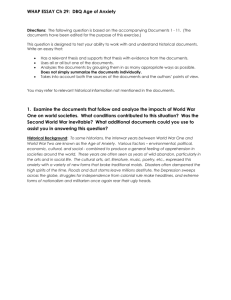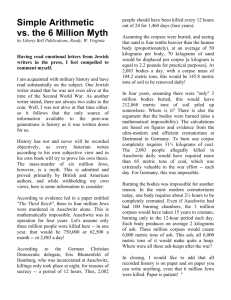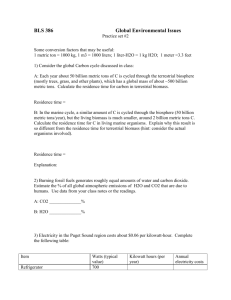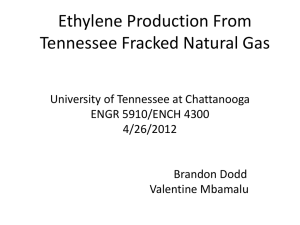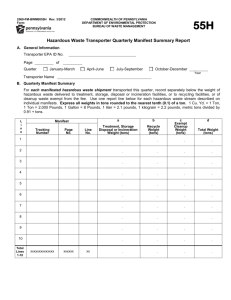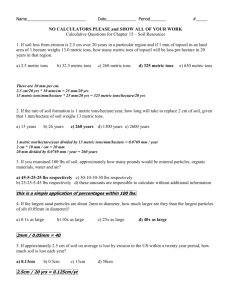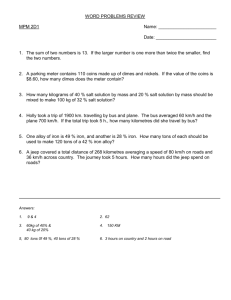Answers to Chpt3
advertisement
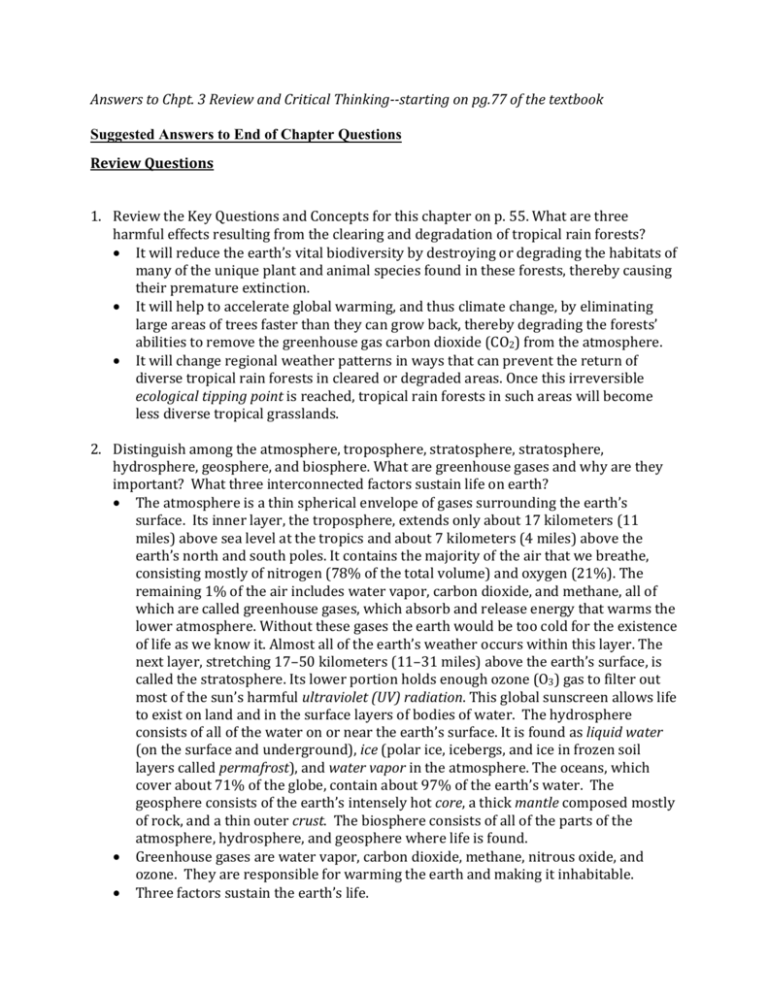
Answers to Chpt. 3 Review and Critical Thinking-­-­starting on pg.77 of the textbook Suggested Answers to End of Chapter Questions Review Questions 1. Review the Key Questions and Concepts for this chapter on p. 55. What are three harmful effects resulting from the clearing and degradation of tropical rain forests? • It will reduce the earth’s vital biodiversity by destroying or degrading the habitats of many of the unique plant and animal species found in these forests, thereby causing their premature extinction. • It will help to accelerate global warming, and thus climate change, by eliminating large areas of trees faster than they can grow back, thereby degrading the forests’ abilities to remove the greenhouse gas carbon dioxide (CO2) from the atmosphere. • It will change regional weather patterns in ways that can prevent the return of diverse tropical rain forests in cleared or degraded areas. Once this irreversible ecological tipping point is reached, tropical rain forests in such areas will become less diverse tropical grasslands. 2. Distinguish among the atmosphere, troposphere, stratosphere, stratosphere, hydrosphere, geosphere, and biosphere. What are greenhouse gases and why are they important? What three interconnected factors sustain life on earth? • The atmosphere is a thin spherical envelope of gases surrounding the earth’s surface. Its inner layer, the troposphere, extends only about 17 kilometers (11 miles) above sea level at the tropics and about 7 kilometers (4 miles) above the earth’s north and south poles. It contains the majority of the air that we breathe, consisting mostly of nitrogen (78% of the total volume) and oxygen (21%). The remaining 1% of the air includes water vapor, carbon dioxide, and methane, all of which are called greenhouse gases, which absorb and release energy that warms the lower atmosphere. Without these gases the earth would be too cold for the existence of life as we know it. Almost all of the earth’s weather occurs within this layer. The next layer, stretching 17–50 kilometers (11–31 miles) above the earth’s surface, is called the stratosphere. Its lower portion holds enough ozone (O3) gas to filter out most of the sun’s harmful ultraviolet (UV) radiation. This global sunscreen allows life to exist on land and in the surface layers of bodies of water. The hydrosphere consists of all of the water on or near the earth’s surface. It is found as liquid water (on the surface and underground), ice (polar ice, icebergs, and ice in frozen soil layers called permafrost), and water vapor in the atmosphere. The oceans, which cover about 71% of the globe, contain about 97% of the earth’s water. The geosphere consists of the earth’s intensely hot core, a thick mantle composed mostly of rock, and a thin outer crust. The biosphere consists of all of the parts of the atmosphere, hydrosphere, and geosphere where life is found. • Greenhouse gases are water vapor, carbon dioxide, methane, nitrous oxide, and ozone. They are responsible for warming the earth and making it inhabitable. • Three factors sustain the earth’s life. o The one-­way flow of high-­quality energy from the sun, through living things in their feeding interactions, into the environment as low-­‐quality energy (mostly heat dispersed into air or water at a low temperature), and eventually back into space as heat. o The cycling of nutrients (the atoms, ions, or molecules needed for survival by living organisms) through parts of the biosphere. o Gravity allows the planet to hold onto its atmosphere and helps to enable the movement and cycling of chemicals through the air, water, soil, and organisms. 3. Describe the flow of energy to and from the earth. What is the natural greenhouse effect and why is it important for life on earth? Define ecology. Define organism, population, and community. Define and distinguish between an ecosystem and the biosphere. • About one-­‐third of the incoming solar radiation is reflected back into space by clouds, particles in the atmosphere, and the earth’s surface. Another fifth of the incoming radiation is absorbed by ozone in the lower stratosphere (mostly UV radiation) and clouds and water vapor in the troposphere. Most of the remaining half of incoming solar radiation is absorbed by land and water on the earth’s surface. • Carbon dioxide and other gases in the troposphere lead to a warming of the troposphere known as the natural greenhouse effect. • Ecology is the biological science that studies how organisms, or living things, interact with one another and with their environment. • An organism is an individual living being. A population is a group of individuals of the same species that live in the same place at the same time. A community, or biological community, consists of all the populations of different species that live in a particular place. • An ecosystem is a community of different species interacting with one another and with their nonliving environment of matter and energy and the biosphere is the part of the earth's air, water, and soil where life is found. 4. Distinguish between the living and nonliving components in ecosystems and give two examples of each. • Biotic: consists of living biological components—plants, animals, and microbes. • Abiotic: consists of nonliving components such as water, air, nutrients, rocks, heat, and solar energy. 5. What is a trophic level? Distinguish among producers (autotrophs), consumers (heterotrophs), and decomposers and detritus feeders and give an example of each in an ecosystem. Distinguish among primary consumers (herbivores), secondary consumers (carnivores), tertiary (third-­‐level) consumers, and omnivores, and give an example of each. • The trophic level, a feeding level, is the level assigned every type of organism in an ecosystem, depending on its source of food or nutrients. • • • • • • • Producers, sometimes called autotrophs (self-­‐feeders), make the nutrients they need from compounds and energy obtained from their environment through a process called photosynthesis, a tree for example. All organisms that are not producers are consumers, or heterotrophs (“other-­‐ feeders”), who cannot produce their own nutrients, a fox for example. Decomposers are consumers that release nutrients from the dead bodies of plants and animals and return them to the soil, water, and air for reuse by producers, mushrooms for example. Detritus feeders feed on the wastes or dead bodies of other organisms. Examples are earthworms, some insects, and vultures. Primary consumers, or herbivores (plant eaters), are animals that eat producers, feeding mostly on green plants. Examples are caterpillars, deer, and zooplankton. Carnivores (meat eaters) are animals that feed on the flesh of other animals. Some carnivores such as spiders, robins, and tuna are secondary consumers that feed on the flesh of herbivores. Other carnivores such as tigers, hawks, and killer whales (orcas) are tertiary (or higher) consumers that feed on the flesh of other carnivores. Omnivores such as pigs, foxes, and humans can eat plants and other animals. 6. Distinguish between photosynthesis and chemosynthesis. Distinguish between aerobic respiration and anaerobic respiration (fermentation). What two processes sustain ecosystems and the biosphere and how are they linked? Explain the importance of microbes. • Producers use photosynthesis to convert CO2 into complex carbohydrates such as glucose (C6H12O6). Producers, consumers, and decomposers use the chemical energy stored in glucose and other organic compounds to fuel their life processes. In most cells, this energy is released by aerobic respiration, which uses oxygen to convert glucose (or other organic nutrient molecules) back into carbon dioxide and water. The net effect of the hundreds of steps in this complex process is represented by the following reaction: glucose +oxygen carbon dioxide+water + energy. This linkage between photosynthesis in producers and aerobic respiration in producers, consumers, and decomposers circulates carbon in the biosphere. Oxygen and hydrogen—the other elements in carbohydrates—cycle almost in step with carbon. • A few producers, mostly specialized bacteria, can convert simple inorganic compounds from their environment into more complex nutrient compounds with-­‐ out using sunlight, through a process called chemosynthesis. • Some decomposers get the energy they need by breaking down glucose (or other organic compounds) in the absence of oxygen. This is called anaerobic respiration, or fermentation. The end products of this process are compounds such as methane gas ( CH4, the main component of natural gas), ethyl alcohol (C2H6O), acetic acid ( C2H4O2, the key component of vinegar), and hydrogen sulfide ( H2S, when sulfur compounds are broken down). • Ecosystems and the biosphere are sustained through a combination of one-­‐ way energy flow from the sun through these systems and nutrient cycling of key • materials within them— two important natural services that are components of the earth’s natural capital. Microbes that decompose dead and decaying plant and animal materials are vital to all ecosystems. Their importance is often ignored, but without them life would not exist. They consist of many different types of bacteria and fungi that secrete enzymes that break down materials from other organisms into smaller components; this enables nutrients to be recycled through the ecosystem as they are taken up from the soil and water by the producers. 7. Distinguish between a food chain and a food web. Explain what happens to energy as it flows through the food chains and food webs. What is biomass? What is the pyramid of energy flow? Why are there more insects than tigers in the world? • A sequence of organisms, each of which serves as a source of food or energy for the next, is called a food chain. Organisms in most ecosystems form a complex network of interconnected food chains called a food web. • Each trophic level in a food chain or web contains a certain amount of biomass. In a food chain or web, chemical energy stored in biomass is transferred from one trophic level to another. With each transfer, some energy is lost as low-­‐quality heat. As energy flows through ecosystems in food chains and webs, there is a decrease in the amount of chemical energy available to organisms at each succeeding feeding level. • Biomass is the dry weight of all organic matter contained in its organisms. • The pyramid of energy flow assumes a 90% energy loss with each transfer in a food chain. • There is such a sharp reduction of energy as we move up trophic levels that there is simply not enough energy at the top to support large populations of top predators such as tigers. At the bottom level, however, there is plenty of energy to support large populations of insects. 8. Distinguish between gross primary productivity (GPP) and net primary productivity (NPP), and explain their importance. • Gross primary productivity (GPP) is the rate at which an ecosystem’s producers (usually plants) convert solar energy into chemical energy in the form of biomass found in their tissues. Net primary productivity (NPP) is the rate at which producers use photosynthesis to produce and store chemical energy minus the rate at which they use some of this stored chemical energy through aerobic respiration. The amount, or mass, of living organic material (biomass) that a particular ecosystem can support is determined by how much solar energy its producers can capture and store as chemical energy and by how rapidly they can do so. 9. What happens to matter in an ecosystem? What is a biogeochemical cycle (nutrient cycle)? Describe the hydrologic, or water cycle. Summarize the unique properties of water. Explain how clearing a rainforest can affect local weather (Core Case study). Explain how human activities are affecting the water cycle. Describe the carbon, nitrogen, phosphorus, and sulfur cycles and explain how human activities are affecting each cycle. Explain how nutrient cycles connect past, present, and future life. • Matter, in the form of nutrients, cycles within and among ecosystems and the biosphere, and human activities are altering these chemical cycles. • The elements and compounds that make up nutrients move continually through air, water, soil, rock, and living organisms within ecosystems in cycles called biogeochemical cycles (literally, life-­‐Earth-­‐chemical cycles), or nutrient cycles. • The hydrological cycle, or water cycle, collects, purifies, and distributes this supply of water. • Water is necessary for life on the earth, and there is a fixed supply of it on our planet. Hydrogen bonds. o Exists as a liquid over a wide temperate range. o Stores a large amount of heat. o Dissolves a variety of compounds. o Filter’s some UV rays from the sun. o Capillary action. o Expands when freezes. o Exists in all three phases at the Earth’s surface • The vegetation in forests is the primary source of local rainfall. • Over land, about 90% of the water that reaches the atmosphere evaporates from the surfaces of plants, through a process called transpiration, and from the soil. • We alter the hydrologic cycle by extracting water from streams, clearing vegetation and altering wetlands. • Carbon is the basic building block of the carbohydrates, fats, proteins, DNA, and other organic compounds necessary for life. In the carbon cycle, carbon circulates through the biosphere, the atmosphere, and parts of the hydrosphere. We alter this cycle by adding large amounts of carbon to the atmosphere. • Nitrogen is a crucial component of proteins, many vitamins, and nucleic acids such as DNA. We alter this cycle by burning fossil fuels, clearing forests, and fertilizing our crops. • Phosphorus circulates through water, the earth’s crust, and living organisms in the phosphorus cycle. We alter this cycle by removing phosphate from the environment to make fertilizers. • Sulfur circulates through the biosphere in the sulfur cycle. We alter this cycle primarily by burning fossil fuels • The law of conservation of matter tells us that these nutrients cannot be destroyed, and so must be recycled. They are constantly cycled through living systems. 10. Describe three ways in which scientists study ecosystems. Describe how satellite and Google Earth technology can be used to help us understand and monitor the natural world and how we are affecting it. Explain why we need much more basic data about the structure and condition of the world’s ecosystems. What are this chapter’s three big ideas? How are the three principles of sustainability showcased in tropical rain forests? • Three approaches ecologists use to learn about ecosystems: field research, laboratory research, and ecosystem models. • • • • Google Earth and satellites offer a snapshot of our most remote ecosystems. Those snapshots, taken over time can be used to monitor change, and thus our affect on ecosystems. We need baseline data on the condition of the world’s ecosystems to see how they are changing and to develop effective strategies for preventing or slowing their degradation. The three big ideas are that: o Life is sustained by the flow of energy from the sun through the biosphere, the cycling of nutrients within the biosphere, and gravity, o Some organisms produce the nutrients they need, others survive by consuming other organisms, and some recycle nutrients back to producer organisms. o Human activities are altering the flow of energy through food chains and webs and the cycling of nutrients within ecosystems and the biosphere. Producers within rain forests rely on solar energy to produce a vast amount of biomass through photosynthesis. Species living in the forests take part in, and depend on cycling of nutrients in the biosphere and the flow of energy through the biosphere. Tropical forests contain a huge and vital part of the earth’s biodiversity, and interactions among species living in these forests help to control the populations of the species living there. Critical Thinking The following are examples of the material that should be contained in possible student answers to the end of chapter Critical Thinking questions. They represent only a summary overview and serve to highlight the core concepts that are addressed in the text. It should be anticipated that the students will provide more in-­‐depth and detailed responses to the questions depending on an individual instructor’s stated expectations. 1. How would you explain the importance of tropical rainforests (Core Case Study) to people who think that such forests have no connections with their lives? Students might focus on the role these forests play as carbon sinks, tying up carbon that might otherwise contribute to climate change. Additionally, the biodiversity in rainforests affects the lives of people around the world because of the medicines that have been discovered there. And finally, weather patterns may be disrupted when the natural holding capacity of the forest is diminished and water simply runs off. 2. Explain why: (a) the flow of energy through the biosphere depends on the cycling of nutrients, and (b) the cycling of nutrients depends on gravity (Concept 3-1B). a. b. 3. The earth is closed to significant inputs of matter and has a fixed supply of nutrients that must be recycled to support life. Energy flows through living things in their feeding interactions, the basic components of which are recycled when plants photosynthesize, making molecules of sugars to be consumed. Gravity holds the atmosphere close to the earth, and enables the cycling of chemicals through air, water, soil, and organisms. Explain why microbes are so important. List two beneficial and two harmful effects of microbes on your health and lifestyle. Write a brief description of what you think would happen to you if microbes were eliminated from the earth. Microbes that decompose dead and decaying plant and animal materials are vital to all ecosystems. Their importance is often ignored but without them life would not exist. They consist of many different types of bacteria and fungi that secret enzymes that break down materials from other organisms into smaller components, and this enables nutrients to be recycled through the ecosystem as they are taken up from the soil and water by the producers. Two beneficial effects of microbes are their role in the recycling of matter and ensuring that there is no build-up of waste in the natural world. They are also used in the production of foods like cheese and yogurt. Two harmful effects of microbes are that they can cause diseases that can be detrimental to an individual’s health, and they can cause food to decay and be rendered unfit for human consumption. 4. Make a list of the food you ate for lunch or dinner today. Trace each type of food back to a particular producer species. Describe the sequence of feeding levels that led to your feeding. Student answers will vary but could include some of the following: if a student had a burger and fries for lunch the bread can be traced back to wheat, the meat to cows and the grain that was fed to them, the lettuce and tomatoes to the original plants, and the fries to potatoes. 5. Use the second law of thermodynamics (see Chapter 2, p. 47) to explain why many poor people in lessdeveloped countries live on a mostly vegetarian diet. The second law of thermodynamics states that in any energy transformation, the energy quality will always decrease and we will end up with less usable energy than we began with. Much of the degraded energy is lost in the form of heat. Energy is lost at each trophic level in a food chain by as much as 90%. The earth can support more people if they ate at a lower level on the food chain by consuming grains, vegetables, and fruits directly. If these crops are fed to animals and pass through another trophic level, more energy is lost in the process. From an economic perspective it is also more costly to buy meat from cattle than it is to buy the grain that was used to feed them. People who live in rich developed countries can afford to live on a diet that is high in meat. However, people in poorer, less developed countries cannot afford to buy meat and live primarily on a vegetarian diet. In doing so they are behaving in a more energy efficient manner and in many cases a healthier one too. 6. Why do farmers not need to apply carbon to grow their crops but often need to add fertilizer containing nitrogen and phosphorus? The crops that farmers grow obtain the carbon that they need directly from the atmosphere in the form of carbon dioxide. As the atmosphere is all around us, the farmer does not have to apply carbon to the fields to grow crops. This is part of the gas phase of the naturally occurring biogeochemical carbon cycle. Although the nitrogen cycle has a gas phase, plants cannot obtain the nitrogen they need directly from the air and must get it in the form of inorganic nitrogen compounds produced in the soil by the nitrogen cycle. Often the farmer grows and harvests crops at such a rate that the nitrogen demand cannot be kept up with by the nitrogen cycle, and so additional nitrogen in the form of fertilizer has to be added to the field. Similarly, phosphate, which does not have a gas phase in its very slow biogeochemical cycle, has to be absorbed into plant crops from the soil in the form of phosphate ions. Again the farmer often grows and harvests crops at such a rate that the naturally occurring levels of phosphate in the soil are diminished. A fertilizer high in phosphates then has to be applied to the field to compensate. 7. What changes might take place in the hydrologic cycle if the earth’s climate becomes: (a) hotter, or (b) cooler? In each case explain how these changes might affect your lifestyle. (a) If the climate became hotter the hydrologic cycle could be adversely affected. The cycle could speed up and change global precipitation patterns, which in turn could affect the severity and frequency of storms, floods, and droughts. It could also enhance global warming by moving more water vapor into the atmosphere. An individual’s lifestyle could be affected by lack of water during droughts, too much water during floods causing landslides and mudslides, or increased exposure to disease causing organisms such as mosquitoes that reproduce in moist, humid climates that could result from increased rainfall in an area. (b) If the climate became cooler the hydrologic cycle could slow down and water would take more time to pass through this natural purification process. More freshwater could be trapped in the form of snow and ice in glaciers for a longer period of time, removing it from use for drinking, etc. by humans. Precipitation patterns could also change. A region may experience longer snow and ice coverage during winter, which could adversely affect the growing season in the area reducing the agricultural output. Another region may experience diminished rainfall, and water shortages could occur as aquifers are replenished at slower rates. Reduced water supplies has profound effects on the lifestyle of inhabitants of a region from not having enough drinking water to water rationing and bans on washing cars and watering lawns. 8. What would happen to an ecosystem if: (a) all its decomposers and detritus feeders were eliminated, (b) all its producers were eliminated, or (c) all of its insects were eliminated? Could a balanced ecosystem exist with only producers and decomposers and no consumers such as humans and other animals? Explain. (a) The ecosystem would not be able to recycle matter, and wastes would build up. Eventually other species would die as no nutrients would be released for plant growth, etc. The ecosystem would be doomed to collapse. (b) The producers form the base of the food chain, and if they were removed then herbivores and subsequently carnivores would eventually die out as they both depend on the producers for the energy that sustains them. The ecosystem would also collapse in this scenario. (c) Ecosystem collapse is inevitable if all insects were removed. Pollination would cease and plant growth would be severely affected. Insects are intrinsically linked to two principles of sustainability (renewable solar energy and recycling of nutrients). Insects play a vital role in implementing these two scientific principles. If these parts of an ecosystem’s function were removed, sustainability cannot be achieved and the ecosystem would become unbalanced and unstable. A fully functioning ecosystem is made up of producers, consumers, and decomposers all interacting with each other and the abiotic components of the environment. The greater the biodiversity of the ecosystem, the greater the balance, stability, and sustainability there is in the ecosystem. Could an ecosystem function with only producers and decomposers? Theoretically a plant could be grown and not eaten by any consumer, then die and be decomposed by bacteria and fungi. However, neither the producers nor the decomposers would function fully. Their role in the ecosystem would not be realized and the ecosystem would be out of balance. Consumers are vital to the sustainable functioning of the ecosystem, whether they are the animals that eat the producers, such as herbivores, or the animals that help decompose the producers, such as the detritus feeders. In order for a balanced ecosystem to exist, it needs all of the interacting components—producers, consumers, and decomposers. 9. List three ways you could apply Concept 3-3 and Concept 3-4 to making your lifestyle more environmentally sustainable. Answers may vary, but may include adopting a vegetarian diet, eating from lower trophic levels (especially in the case of many fish species that are top carnivores), and composting to recycle waste back into productive systems. 10. List two questions that you would like to have answered as a result of reading this chapter. Student answers will vary and provide a good starting point for class discussion. Ecological Footprint Question ANSWERS: 1. Country Total Carbon Footprint-­‐ Population Per Capita Carbon Carbon Dioxide Emissions in in billions Footprint Gigatonnes (109metric tons) (2007) (Per Capita Carbon [Gigatons (109short tons)] Dioxide Emissions per per year year) China 5.0 (5.5) 1.3 3.8 metric tons (4.2 tons]) India 1.3 (1.4) 1.1 1.2 metric tons (1.3 tons) Japan 1.3 (1.4) 0.13 10 metric tons (11 tons) Russia 1.5 (1.6) 0.14 11 metric tons (12 tons) United 6.0 (6.6) 0.30 20 metric tons (22 tons) States WORLD 29 (32) 6.6 4.4 metric tons (4.8 tons) China: 5.0 X 109 metric tons/1.3 X 109 people = 3.8 metric tons per person 5.5 X 109 tons/1,3 X 109 people = 4.2 tons per person India: 1.3 X 109 metric tons/1.1 X 109 people = 1.2 metric tons per person 1.4 X 109 tons/1.1 X 10 people = 1.3 tons per person Japan: 1.30 X 109 metric tons/0.133 X 109 people = 10 metric tons per person 1.4 X 109 tons/0.13X 109 people = 11 tons per person Russia: 1.5 X 109 metric tons/0.14 X 109 people = 11 metric tons per person 1.6 X 109 tons/ 0.14 X 109 people = 12 tons per person United States: 6.0 X 109 metric tons/0.30 X 109 people = 20 metric tons per person 6.6 X 109 ton / 0.30 X 109 people = 22 tons per person World : 29 X 109 metric tons/6.6 X 109 people = 4.4 metric tons per person 32 X 109 tons/6.6 X 109 people = 4.8 tons per person 2. (a) How many times larger is the U.S. carbon footprint than the sustainable level? 20 metric tons CO2 /person/year = 10 times greater 2.00 metric tons CO2 /person/year 22 tons CO2 /person/year = 10 times greater 2.20 tons CO2 /person/year 2. (b) How many times larger is the U.S. carbon footprint than the world average? 2020 metric tons CO2/person/year = 4.5 times greater 4.4 metric tons CO2/person/year 22 tons CO2/person/year = 4.6 (4.58 times greater 4.8 tons CO2 /person/year 3. By what percentage will China, Japan, Russia, the United States, and the world each have to reduce their carbon footprints per person to achieve the estimated maximum sustainable carbon footprint per person of 2.0 metric tons (2.2 tons) per person per year? China: 3.8 metric tons per person – 2.0 metric tons per person = 1.8 metric tons per person 1.8 metric tons per person/3.8 metric tons per person x 100 = 47% Japan: 10 metric tons per person – 2.0 metric tons per person = 8.0 metric tons per person 8.0 metric tons per person/10 metric tons per person x 100 = 80% Russia: 11 metric tons per person – 2.0 metric tons per person = 9.0 metric tons per person 9.0 metric tons per person/11 metric tons per person x 100 = 82% United States: 20 metric tons per person – 2.0 metric tons per person = 18 metric tons per person 18 metric tons per person/20 metric tons per person x 100 = 90% World: 4.4 metric tons per person – 2.0 metric tons per person = 2.4 metric tons per person 2.4 metric tons per person/4.4 metric tons per person x 100 = 55%
